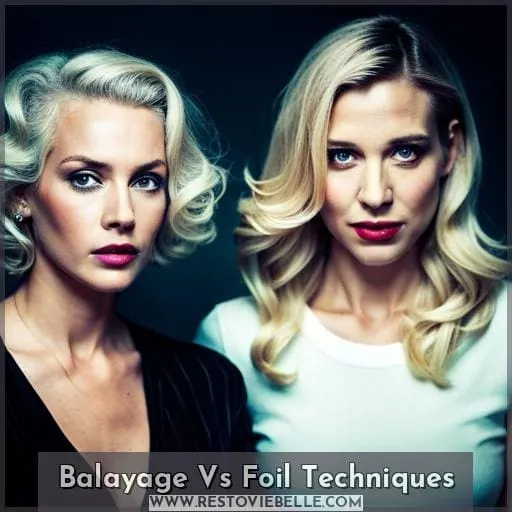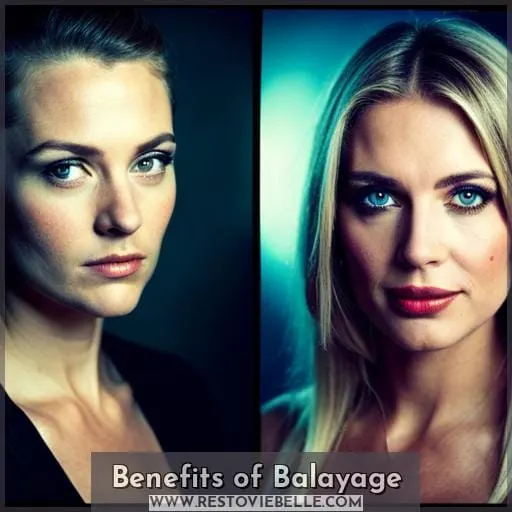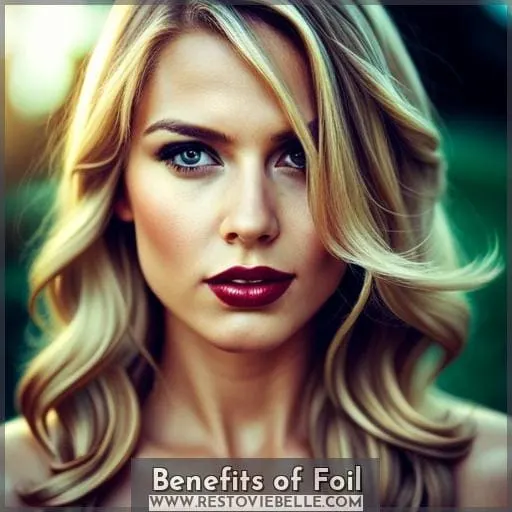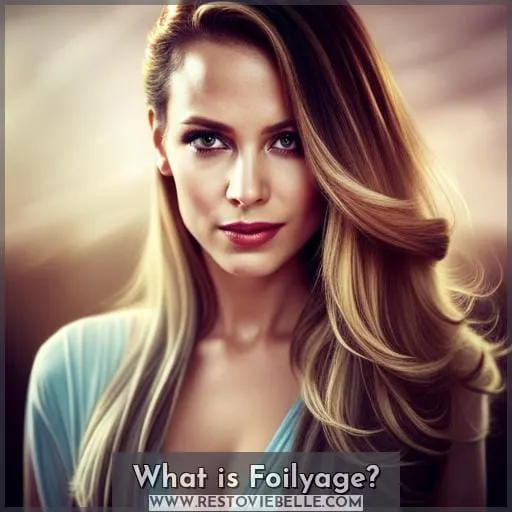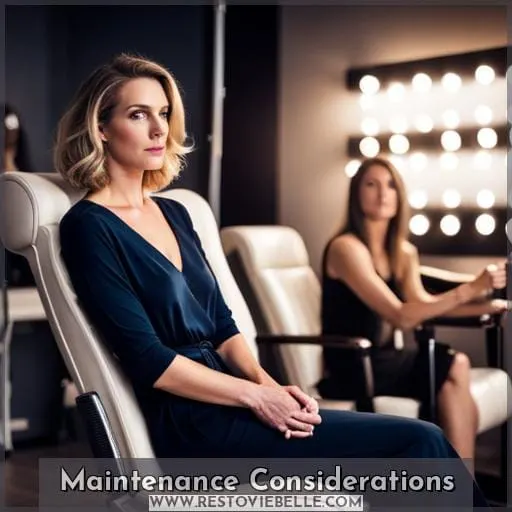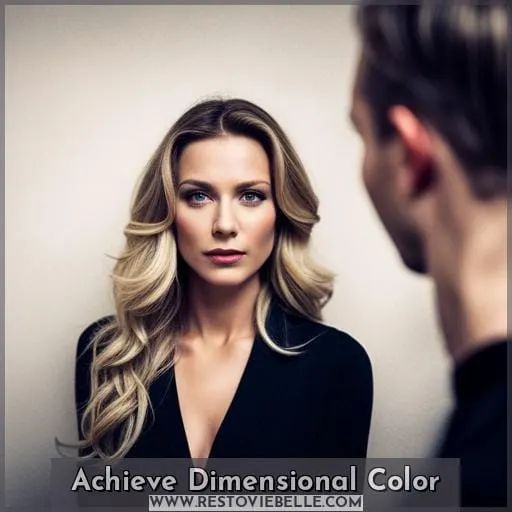This site is supported by our readers. We may earn a commission, at no cost to you, if you purchase through links.
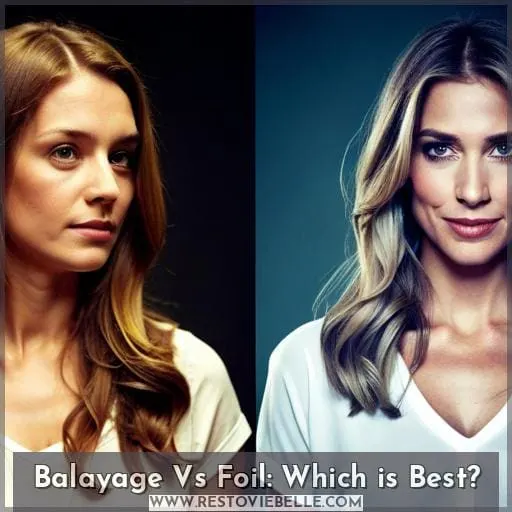 Feeling torn between balayage and foil for your next hair color? Discover the key differences to help you decide which technique is best for you.
Feeling torn between balayage and foil for your next hair color? Discover the key differences to help you decide which technique is best for you.
Balayage offers a natural, low-maintenance look with subtle grow out, while foils provide precise application and maximum lightening.
Unsure how these techniques will suit your unique style? Consult our expert stylists who can bring your desired look to life.
Say goodbye to indecision and hello to dimensional color that empowers you!
Table Of Contents
Key Takeaways
- Balayage creates soft, natural-looking highlights while foil can achieve more precise, intense results.
- Balayage requires less frequent touch-ups compared to foil highlights.
- Both techniques can be used to create dimensional color, with balayage being more subtle.
- Consult a stylist to determine which technique is better suited for your hair type and desired look.
Balayage Vs Foil Techniques
When considering the best hair coloring technique for you, it’s important to understand the differences between balayage and foil techniques.
Balayage involves hand-painting color in sweeping motions to create soft, blended highlights with subtle regrowth.
Foils place hair sections in aluminum wrapping to apply lightener or color for defined, striking results. This precision application creates vibrant dimension yet demands regular touch-ups as regrowth appears stark.
While balayage excels for low maintenance with a trendy lived-in vibe, foils help achieve dramatic transformations with striking pops of color.
Consult a seasoned stylist to determine which technique aligns with your personal style, lifestyle and hair texture. Stylists also skillfully combine both methods for customized looks, like “foilyage” which fuses balayage’s softness with all-over foil brightness.
Discuss preferences, upkeep and hair goals with an expert for the best dimensional color.
Benefits of Balayage
When it comes to choosing between balayage and foil highlights, there are several benefits of opting for balayage.
One major advantage is the natural look it provides, creating a sun-kissed effect with soft, blended color transitions.
Additionally, balayage requires lower maintenance compared to foils as touch-ups are needed less frequently due to its subtle grow-out.
So if you’re looking for a low-maintenance option that offers a natural appearance, then balayage may be the best choice for you.
Natural Look
You’ll get a natural look with balayage as the hand-painted technique creates soft, blended highlights that mimic natural light, giving hair dimension while avoiding an overly processed appearance.
The freehand method produces an organic, sun-kissed radiance with effortless elegance, as if naturally graced by the painter’s palette.
Achieve a natural glow without the high-maintenance salon visits foils require.
Lower Maintenance
For those seeking a beautiful hair color with minimal upkeep, balayage offers the benefit of lower maintenance.
Unlike traditional foil highlights that require touch-ups every 6-8 weeks, balayage allows for longer periods between salon visits.
With its natural appearance and subtle color transitions, regrowth is less noticeable compared to foils.
Balayage also provides the flexibility for customization based on personal preference and seasonal adaptability while offering versatile styling options.
Subtle Grow Out
With balayage, you can enjoy a subtle grow out as your hair naturally transitions between colors.
The technique is known for less noticeable regrowth and creating a customizable, natural-looking, face-framing effect.
Balayage offers a low-maintenance grow out since the highlights are mainly focused on the mid-lengths and ends rather than at the roots like traditional foil highlights.
Benefits of Foil
When opting for foil highlights over balayage, you gain advantages in precision, lightening power, and definition.
The aluminum foils allow the colorist to neatly section off hair and apply bleach in a very controlled manner, achieving maximum lightening. This leads to a sharply defined highlighted look with excellent separation between colored pieces.
Precise Application
To achieve a defined and controlled appearance, foils offer precise color application and separation.
Defined lines and sharper demarcation are created compared to balayage.
Furthermore, foils offer the flexibility to adjust thickness for varied looks.
The aluminum foil aids color absorption by conducting heat more efficiently.
Ultimately, foils enable a stylist to have more control over placement for a precise, defined color result.
Maximum Lightening
Get the maximum lightening effect with foils.
Foil are perfect for achieving a defined and vibrant look, especially for cold blondes or those looking for intense color.
The foiling process allows for precise application, ensuring that each strand is evenly coated and lightened to its fullest potential.
Whether you’re aiming to create high-contrast highlights or seamlessly blend colors together, foils offer maximum control and stunning results in the art of color blending.
Defined Look
You’re seeking a defined look with precise color separation, so foil highlights offer sharper demarcation lines between colors compared to balayage.
Foils allow for:
- More control over placement
- Ability to create patterns
- Adjust thickness as desired
- Works well with face-framing highlights
Foils allow for precise color application and control over color separation through defined lines with adjustable thickness. This makes them an ideal option if you want dimension with face-framing highlights or other placed patterns.
What is Foilyage?
Now let’s dive into the exciting world of foilyage, a technique that blends the best of both balayage and foil highlights. Foilyage is a combination approach that offers the natural appearance of balayage with added intensity achieved through foils.
This technique is particularly suitable for those with fine or thin hair that may be prone to breakage.
Foilyage allows for color change without significant damage to your hair. It involves painting color onto specific sections of your hair, just like in traditional balayaging, while incorporating foils to add brightness and dimension.
For brunettes looking to add depth and richness to their locks, foilyaged highlights can provide stunning results by utilizing different shades within similar tonal ranges. On the other hand, blondes can achieve maximum lightening effects using this technique as it allows for precise placement on darker tones.
Whether you’re a brunette or blonde looking for dimensional highlights or seeking an overall transformation in color tone, consider giving foilyage a try! Consult with your stylist who’ll guide you on whether this technique suits your desired look best.
Best Candidates for Balayage
When seeking subtle sun-kissed color, those with longer hair benefit from balayage for a natural yet impactful look.
-
All hair types can achieve a beautiful balayage, though it excels on specific hair types.
- Those with fine or damaged hair appreciate balayage’s gentle approach that avoids further dryness or breakage.
- Additionally, balayage works well on both light and dark hair. The hand-painted technique creates a beautiful contrast, adding dimension.
- Those with longer hair lengths gain the most from balayage placement concentrated on the mid-lengths and ends. Short hair may not capture the full effect. An oval or long face shape best carries off balayage’s soft, face-framing color.
Overall, balayage proves versatile across many hair types and textures. Yet its dimension-building properties stand out on long, damaged, or fine hair seeking lightweight color enhancement with a natural look.
The technique ultimately focuses on creating lived-in, beachy color concentrating on the mid-lengths and ends.
Best Candidates for Foils
For those who prefer a more defined and controlled look for their highlights, foils are the best choice.
The precision of the foil method allows for maximum lightening and vivid, consistent color on all hair types.
Those with fine hair seeking to add major dimension will benefit from the intense color payoff and customizability of foils.
Individuals with darker hair tones wishing to achieve lighter blondes and trendy hues like grey are prime candidates.
While foils demand more frequent touch-ups to maintain consistent color and require more effort compared to balayage, the payoff is dimension that pops.
If low maintenance is preferred, balayage excels.
But foils enable hair stylists to truly customize looks from subtle sunshine kisses to dramatic transformations aligning with personal style.
For dynamic, head-turning color that commands attention, foils deliver.
Maintenance Considerations
When considering maintenance for balayage vs foil highlights, there are several key factors to take into account.
- Frequency is an important consideration, as foils typically require touch-ups every 6-8 weeks compared to balayage’s longer time frame of 3-6 months.
- Cost is another factor, as the more frequent touch-ups required with foils can add up over time.
- Additionally, upkeep effort should be considered – while both techniques require some level of maintenance and care, the natural appearance and blended color transitions of balayage often result in less noticeable regrowth compared to foil highlights.
Frequency
To maintain your color, consider the frequency of touch-ups and maintenance for both balayage and foil techniques.
- Foil highlights typically require touch-ups every 6-8 weeks.
- Balayage, on the other hand, only requires touch-ups every 3-6 months.
- Highlights usually need to be touched up every 8-12 weeks.
By understanding these timelines, you can plan your salon trips accordingly and ensure long-lasting color with low maintenance. Don’t forget to also take into account factors such as washing frequency, gloss treatments, sun protection to extend the lifespan of your beautiful hair color.
Cost
You’ll incur some additional costs with foils since they require more frequent touch-ups compared to balayage.
| Technique | Touch-Up Frequency | Total Cost Over 1 Year |
|---|---|---|
| Balayage | Every 4-6 months | $300 |
| Foil Highlights | Every 6-8 weeks | $600 |
As shown, balayage is generally less expensive given the less frequent salon visits needed.
Upkeep Effort
Maintaining your hair color is an important factor to consider when choosing between balayage and foil highlights.
Balayage requires less frequent touch-ups, with a subtle regrowth that blends seamlessly for a natural look. This low-maintenance option allows you to enjoy professional results while minimizing future maintenance efforts.
Foil highlights, on the other hand, may require more upkeep due to noticeable regrowth. Consider your desired level of maintenance and the impact on your natural hair texture before making a decision, especially if you have damaged hair or prefer lower maintenance blonde highlights.
Consult a Stylist on Best Option
For the best decision between balayage and foils, consult a stylist who can provide expert guidance based on your unique hair type and desired results.
Here’s why consulting with a stylist is crucial:
- Personalized Recommendation: A skilled colorist will assess your hair’s condition, texture, and natural color to determine which technique suits you best.
- Expert Knowledge: A stylist has in-depth knowledge of both balayage and foil techniques, allowing them to advise you on the most suitable option for achieving your desired look.
- Goal-Oriented Approach: By discussing your goals with a professional, they can recommend the technique that aligns with what you want to achieve while considering factors like maintenance requirements and long-term upkeep.
Remember that every person’s hair is unique, so it’s important to consult with an experienced stylist before making any decisions about coloring techniques or treatments. They’ve the expertise necessary to guide you towards the best option for beautiful results tailored specifically to you.
Achieve Dimensional Color
When transitioning from discussing the importance of consulting a stylist to determining the best option, you’d do well focusing on how both balayage and foils can create multidimensional color effects that liven up your look.
Balayage offers a natural, hand-painted technique that achieves a sun-kissed appearance with subtle transitions between colors. On the other hand, foil highlights provide precise application and defined lines for more controlled color placement.
To help you understand which technique is best suited for achieving dimensional color in your hair, refer to the table below:
| Technique | Description |
|---|---|
| Balayage | Hand-painted technique for natural-looking results with soft transitions between colors |
| Foil Highlights | Precise application using foils to achieve more control over color placement |
Both techniques have their unique benefits when it comes to creating dimension in your hair. Whether you prefer a more effortless and blended look or crave precision and definition, considering factors such as personal preference, desired maintenance level, and overall style goals will guide you towards making an informed decision about which method suits you best.
Frequently Asked Questions (FAQs)
Is foilyage suitable for all hair types?
Foilyage is a versatile technique suitable for all hair types. It combines the natural, blended look of balayage with the precision and brightness of foils.
Whether you have fine or thick hair, you can achieve stunning results with foilyage.
How often should I touch up my balayage highlights?
To maintain your balayage highlights, touch-ups are typically needed every 3 to 6 months.
This timeframe allows for a natural grow-out and reduces maintenance compared to other highlighting techniques.
Consult with your stylist for personalized recommendations based on your specific hair type and desired look.
Can foils be used to create a natural, sun-kissed look?
Yes, foils can create a natural, sun-kissed look when placed subtly around the face and ends.
Strategic foil placement with a sheer application of lightener provides soft, face-framing dimension.
When applied by a skilled colorist, foils can mimic balayage’s effortless aesthetic.
What is the recommended maintenance routine for foils?
For consistent color with foils, plan for touch-ups every 6-8 weeks.
Regular gloss treatments, toning shampoos, heat/UV protection, and avoiding daily washes also help maintain vibrancy between appointments.
Consult your colorist for personalized recommendations on at-home care and ideal retouch frequency for your hair.
How can I achieve a dimensional color with balayage or foils?
To achieve dimensional color, consult a professional stylist about incorporating balayage painting or foil highlighting techniques.
Thoughtfully blending lowlights, highlights, and your natural tone creates lovely depth and dimension.
Conclusion
To choose between balayage and foil for your next hair color, consider your desired look and maintenance preferences.
Balayage offers a natural, low-maintenance style with subtle grow out, while foils provide precise application and maximum lightening.
Foilyage is also an option, combining the benefits of both techniques.
Balayage is best for those seeking a natural look, while foils are ideal for those who want a defined, lighter result.
Consult a stylist to determine the best option for your unique style and achieve dimensional color that empowers you.
